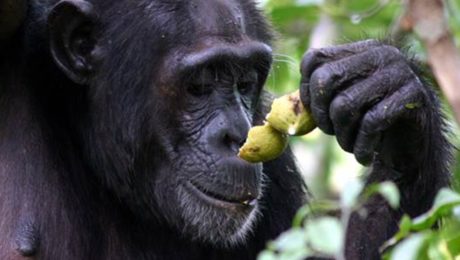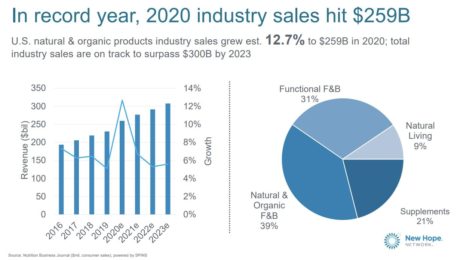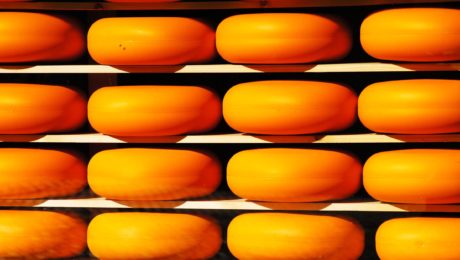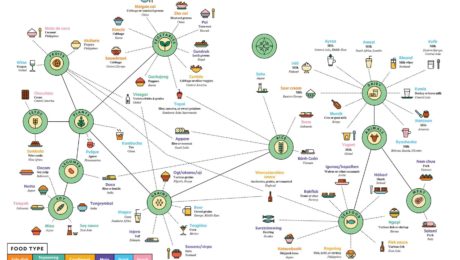Fermented Foods Fighting Food Insecurity
Fermenti Foods has teamed up with a local salt producer to help food insecurity in their local county of Madison County, North Carolina.
Meg Chamberlain (pictured) donates jars of her fermented kraut and carrots to the Beacon of Hope Food Bank. She’s also helped the food bank preserve fresh food donations. And now she’s adding recipes for sauerkraut and tutorials on YouTube. Chamberlain says fermentation is a useful tool for home preservation.
“In addition to the fact that more people are growing, they need to know what to do with what they’re growing in their gardens,” she said.
Read more (Citizen Times)
Primates & Fermented Food
Humans have been fermenting for thousands of years; now, an anthropologist has published evidence that several other primate species also feed on fermented food.
Katherine Amato, at Northwestern University, compiled evidence from 151 biologists who study the feeding habits of 40 primate species from Asia, Africa and the Americas. Fifteen of those species consume fruit in the late stages of fermentation, and thatermented fruit makes up 3% of their diet. Though the scale is small, the evolutionary roots are interesting.
“Of the 44 types of fruit eaten in an advanced state of fermentation, 16 had tough husks that the animals could not easily open unless they were first fermented, and 25 contained digestion-impeding or toxic chemicals like tannins and alkaloids that fermentation tends to destroy,” reads an article in The Economist on the research.
It continues: “Several of the fermented-fruit-eating primates alive today split off from the line that leads to people well over 10m years ago. Presumably, they have evolved their own genetic arrangements for dealing with fermentation products and the microbes that produce them. Nevertheless, Dr. Amato’s work suggests that human beings’ love of the fermented does, indeed, have deep evolutionary roots.”
Read more (The Economist)
- Published in Science
Cautionary Notes about Probiotics
Do probiotic supplements deliver the same benefits as fermented foods? Dr. Gail Cresci says to be leery of prebiotic and probiotic pills.
“There are challenges to keeping microbes viable in encapsulated tablets,” says Cresci, director of Nutrition Research for the Cleveland Clinic’s Department of Pediatric Gastroenterology, Hepatology and Nutrition. “It’s also very, very important to know that each strain of bacteria is not the same as the next. For example, lactobacillus has hundreds of different strains, and each one may behave differently. People like to use supplements because they like to think one size fits all, but it doesn’t.”
“Take in prebiotics and probiotics through food sources. Yogurt with added probiotic bacterial strains is much better to consume than supplements also because as it’s been waiting for you to eat it, it’s been producing more beneficial metabolites. When you eat it, you get all that.”
Read more (American Heart Association/U.S. News & World Report)
The New Definition of Fermented Food
After Dr. Bob Hutkins finished a presentation on fermented foods during a respected nutrition conference, the first audience question was from someone with a PhD in nutrition: “What are fermented foods?”
“I thought ‘Doesn’t everyone know what fermentation is?’ I realized, we do need a definition. Those of us that work in this field know what we’re talking about when we say fermented foods, but even people trained in foods do not understand this concept,” says Hutkins, a professor of food science at the University of Nebraska-Lincoln. He presented The New Definition of Fermented Foods during a webinar with TFA.
Hutkins was part of a 13-member interdisciplinary panel of scientists that released a consensus definition on fermented foods. Their research, published this month in Nature Reviews Gastroenterology & Hepatology, defines fermented foods as: “foods made through desired microbial growth and enzymatic conversions of food components.”
“We needed a definition that conveyed this simple message of a raw food turning into a fermented food via microorganisms,” Hutkins says. “It brings some clarity to many of these issues that, frankly, people are confused about.”
David Ehreth, president and founder of Alexander Valley Gourmet, parent company of Sonoma Brinery (and a TFA Advisory Board member), agreed that an expert definition was necessary.
“As a producer, and having started this effort to put live culture products on the standard grocery shelf, I started doing it as a result of unique flavors that I could achieve through fermentation that weren’t present in acidified products,” Ehreth says. “Since many of us put this on our labels, we should be paying close attention to what these folks are doing, since they are the scientific backbone of our industry.”
Hutkins calls fermented foods “the original shelf-stable foods.” They’ve been used by humankind for over thousands of years, but have mushroomed in popularity in the last 15. Fermented foods check many boxes for hot food trends: artisanal, local, organic, natural, healthy, flavorful, sustainable, innovative, hip, funky, chic, cool and Instagram-worthy.
Nutrition, Hutkins hypothesizes, is a big driver of the public’s interest in fermentation. He noted that Today’s Dietitian has voted fermented foods a top superfood for the past four years.
Evidence to make bold claims about the health benefits of fermentation, though, is lacking. Hutkins says there is observational and epidemiological evidence. But randomized, human clinical trials — “the highest evidence one can rely on” — are few and small-scale for fermented foods.
Hutkins shared some research results. One study found that Korean elders who regularly consume kimchi harbor lactic acid bacteria (LAB) in their GI tract, providing compelling evidence that LAB survives digestion and reaches the gut. Another study of cultured dairy products, cheese, fermented vegetables, Asian fermented products and fermented drinks found that most contain over 10 million LAB per gram.
Still, the lack of credible studies is “a barrier we have to get past,” Hutkins says. There are confirmed health benefits with yogurt and kefir, but this research was funded by the dairy industry, a large trade group with significant resources.
“I think there’s enough evidence — most of it through these associated studies — to warrant this statement: fermented foods, including those that contain live microorganisms, should be included as part of a healthy diet.”
Are Fermented Foods Probiotics?
Probiotics and fermented foods are not equivalent, says Mary Ellen Sanders, PhD and executive science officer of the International Scientific Association of Probiotics & Prebiotics (ISAPP). She advises fermented food producers that don’t meet the criteria of a probiotic to use descriptors such as “live active cultures” or “fermented food with live microbes” on their labels rather than “probiotic.”
“There are quite a few differences between probiotics and many fermented foods. You cannot assume a fermented food is a probiotic food even if it has live cultures present,” says Sanders. She highlighted her 30 years worth of insight into the field during a TFA webinar, Are Fermented Foods Probiotics?
Some fermented foods do meet these criteria, such as some yogurts and cultured milks that are well-studied. But many traditional fermented foods do not.
Using multiple peer-reviewed scientific studies and conclusion from expert panels in the fields of probiotics and fermented foods, Sanders shared the ways in which fermented foods and probiotics differ:
- Health benefits
By definition, a probiotic must have a documented health benefit. Many fermented foods have not been tested for a health benefit.
“If you are interested in recommending health benefits from a fermented food in an evidence-based manner, many traditional fermented foods fall short. They don’t have the controlled randomized trials that will provide a causal link between the food and the health benefit,” she says. “A food may be nutritious, but probiotic benefits must stem from the live microbe, not the nutritional composition of the food. Otherwise you just have a nutritious food that happens to have live microorganisms in it. You don’t have a probiotic food.”
- Quality studies
In her presentation, Sanders shared multiple randomized clinical trials on human subjects with supported health evidence for probiotics. But there are few randomized, controlled studies on fermented foods. Most are cohort studies, which inherently have a higher risk of bias and cannot provide a causal link between consuming fermented foods and a health benefit.
“A strong hypothesis is not the same as proof,” Sanders says. “Evidence for probiotics must meet a higher standard than small associative studies, many of which are tracking biomarkers and not health endpoints.”
She noted, though, there are some studies on fermented milk and yogurt that show a conferred health benefit.
- Strain designation
Though many fermented foods do have live microbes, a probiotic is required to be identified to the strain level. The genus and species should also be properly named according to current nomenclature. Many fermented foods contain undefined microbial composition. Without that strain designation, one can’t tie the scientific evidence on that strain to the probiotic product.
- Microbe quantity
Another key differentiator is that probiotics must be delivered at a known quantity that matches the amount that results in a health benefit. Probiotics are typically quantified in colony forming units (or CFUs).
“A probiotic has a known effective dose. But fermented foods often contain unknown levels of microbes, especially at time of consumption,” Sanders says.
What Can Brands Do?
If food brands keep using the word probiotics as a catch-all to describe a fermented product, the term will lose its utility. Using “probiotics” on food with unsubstantiated proof of probiotics is a misuse of the term.
“When I see a fermented food that says probiotics on it, I very often think what they’re trying to communicate on that label [is that it] contains live microbes,” Sanders says, “because I’m doubting, at least some of the products I see, that they have any evidence of a health benefit. And so they’re just looking for a catchy, single word that will communicate to people that this has live microbes in it. ‘Live active cultures’ is something that resonates with people as well. So why not use that?”
Sanders encourages fermented brands to standardize the terms “live active cultures,” “live microbes,” “live microorganisms” or “fermented food with live microbes.” For products pasteurized after fermentation, there’s a term for them too: “Made with live cultures.”
Controlled human studies on fermented foods can be challenging, Sanders admits. Such studies can be difficult to properly blind, since placebos for foods are hard to design. The fermentation process affects the product taste so that study subjects may know what they are consuming. But the health benefits of fermented foods could be studied, though. She also advises producers to focus on the nutritional value of their food.
“That’s one thing that really has me excited about this concept of core benefits,” says Maria Marco, PhD, professor of food science and technology at University of California, Davis (and a member of TFA’s Advisory Board) and moderator of the webinar. “I think it kind of opens the doors to the possibility of fermented fruits and vegetables where there’s certain organisms, microorganisms that we’d expect to be there but again we need to know really if those microorganisms are needed to make those foods healthy.”
Natural & Organic Sales Grow Big in 2020
Natural and organic products had a record year in 2020, growing 12.7% to $259 billion in sales. Sales were fast-tracked by the pandemic, as consumers cooked more meals at home in quarantine and developed a greater interest in healthier food and beverages.
“2020 was a challenging year. But natural and organic brands face a bright future. We are positioned where a growing number of consumers are headed,” says Carlotta Mast, senior vice president and market leader at New Hope Network. Mast shared industry highlights during her State of Natural & Organic address at New Hope’s Spark Change virtual conference earlier this month.
Natural and organic food and beverages (39%of total sales) and functional food and beverages (31%) dominate the industry. The natural and organic category alone grew 13% to $186 billion in sales. Produce accounted for 24% of those sales. Beverages were 17% of the total; dairy, 15%; packaged/prepared foods, 13%; breads and grains, 11%; snacks, 8%; meat, fish and poultry,7% and condiments, 5%.
Here are some key trends from this banner sales year:
- Consumers Prioritize Health
Consumers want immunity-boosting foods. Brands should consider adding vitamins and minerals to their products, as nutrient-dense food will be core to the future of food production.
Nutrient density “is very difficult to market,” says Nick McCoy, managing director and co-founder of Whipstitch Capital, a food-focused investment bank. “It manifests itself as superfoods over time, but it’s one of these things, if you’re in a natural grocery store, historically not many shoppers are going to take the time to read the label. It’s really encouraging to see that this is reversing.”
Adds Kathryn Peters, executive vice president at SPINS, a data company for the natural and organic industry: “Consumers are expecting more from the products they buy. But another key piece is consumers are expecting more density of nutrition in the products they buy.”
- Wellness is Challenging to Maintain
Consumers are focusing on health and wellness more than ever — 77% of New Hope Network survey respondents said personal health is more important to them now than it was in 2019.
But research shows consumers are struggling to maintain healthy lifestyles. People said they ate more junk food, exercised less, felt more anxious and slept less during 2020. Binge drinking is up an alarming 41% among women since the start of the pandemic.
Brands, Mast says, can help people fix bad habits.
“I think this is our big opportunity for 2021 and beyond,” Mast says.
- Diet as Lifestyle
SPINS’ Peters says she anticipates that, “as we look to resurrect our former selves,” shoppers will look for new eating plans, ones they can personalize to their needs.
She highlighted a few trends. Consumers want less sugar and fewer carbs and additives. They’re also shifting buying habits based on the trend to Paleo and Keto diets. Plant-based products, too, are estimated to grow at twice the rate of their traditional counterparts. Plant-based products grew 30% from 2019 to 2020, hitting $5.7 billion in sales.
Pantry staples, frozen foods, meat/fish/poultry and plant-based alternatives experienced the highest growth rates. Snack foods and packaged and prepared foods — which had previously experienced large sales gains — took big hits in 2020 as fewer people chose grab-n-go offerings during quarantine.
“How is your brand interacting with what consumers are looking for today?” Peters says.
- Multicultural Foods Grow
Of health and wellness products in the U.S., only 20% are multicultural, according to the Nutrition Business Journal.
“That tells me there’s a lot of room for better-for-you multicultural foods to grow into the profile of all the other categories,” Whipstitch’s McCoy says.
- Differing Preferences for eCommerce or Brick-and-Mortar
The pandemic accelerated ecommerce sales, which grew 60% in 2020, generating $16.5 billion. Natural products are outpacing traditional ones in ecommerce, with natural product shoppers spending nearly twice as much as those who buy “traditional” items via ecommerce. And, while “traditional” shoppers spend 22% of their dollars at WalMart, natural product shoppers only use WalMart for 12% of their purchases.
“As you all know, organic is mainstream now,” Mast continued, noting that natural sales remained high in 2020 even as unemployment rates soared. “During other economic downturns that we’ve experienced, the organic sector has typically taken a hit when it comes to sales growth. But not in 2020.”
- Published in Business
Trends in Pandemic Eating
Consumers increasingly embraced adventurous and healthy food over the last twelve months, but “a big pandemic winner is fermented foods.”
An article from the Associated Press details how, now a year into isolation, people are cooking beyond comfort food. They’re “embracing foods long forgotten or rejected for taste, texture or smell.” Anne Alderete (pictured) details how she is finally enjoying natto (fermented soy beans) after rejecting it for years.
Read more (Associated Press)
- Published in Food & Flavor
Cheese Doesn’t Deserve Its Bad Reputation
Why do we treat cheese like a guilty pleasure when studies have shown time and again that cheese can be good for you? An article in Wired sheds light on how cheese gained its designation as a villain in the food pyramid. One key element is how many Americans ate in the ‘80s and ‘90s, layering pizza and pasta with heavily-processed cheese.
The article reads: “In the case of cheese, there could be several reasons for the surprising lack of impact on weight, though more research is needed. Cheese is fermented, meaning it has live bacterial cultures. That could have a positive effect on the gut microbiome, which appears to play a role in weight regulation. The fermentation process also creates vitamin K2, or menaquinone, which experimental studies have linked to improved insulin function. Insulin regulates blood sugar levels, hunger, calorie expenditure, and fat storage. (One upshot is that hard, aged cheeses, which are more fermented, probably provide more benefit than soft, less fermented ones.) There’s also some promising research about the benefits of a compound called the milk-fat globule membrane, which is intact in cheese but not in milk or butter.”
Read more (Wired)
The World of Fermented Foods
In the latest issue of Popular Science, a creative infographic illustrates “the wonderful world of fermented foods on one delicious chart.” It represents “a sampling of the treats our species brines, brews, cures, and cultures around the world,” and is particularly interesting as it shows mainstream media catching on to fermentation’s renaissance. Fermentation fit with the issue’s theme of transformation in the wake of the pandemic.
Read more (Popular Science)
- Published in Food & Flavor
EATLAC Studies, Educates on Fermentation
A new project is aiming to provide accurate information and resources to the public around the microbial mysteries of fermented foods. EATLAC is a University of California, Davis, project putting scientific knowledge and research behind fermentation.
“A good understanding of food and beverage fermentation is particularly important for people making fermented foods at home so that the foods are made properly and minimize the risk of foodborne illness,” says Maria Marco, PhD, microbiologist and professor in the department of food science and technology at the university (and member of TFA’s Advisory Board). “Access to accurate information about fermented foods is quite important for understanding their roles in healthy diets and what properties about them are different from the starting ingredients.”
EATLAC officially launched in 2019, with the help of funding from California Department of Food & Agriculture. Led by project directors Marco and Erin DiCaprio, PhD, a food safety expert and extension specialist at UC Davis, the EATLAC team is composed of grad and undergrad students helping to develop science-based guidance on fermented vegetables and fruits. Resources being developed in the project include recipes, consumer surveys, and webinars. This information will be available to the general public, from home fermenters to commercial producers.
The name EATLAC stands for Evaluating And Testing Lacto-ferments Across the Country, but LAC is also a play on words for lactic acid bacteria, the beneficial bacteria present in fermented foods.
Project objectives include:
- Developing educational materials on fermented foods.
- Conducting public education workshops on fermented foods.
- Measuring the bioactive properties of unpasteurized (fresh) fermented fruits and vegetables produced from specialty crops in California.
- Disseminating research findings to food processors.
“It is very important to spread reliable information and vetted recipes so that everyone can create something that is great but, more importantly, safe,” says Zoe Mitchell, undergraduate student at UC Davis. “Fermentation requires that food be left out on the counter (in the microbial temperature danger zone) for days on end. To create a safe fermentation environment that supports the growth of the microbes we want, recipe ingredients include things like acid and salt to inhibit pathogens. However, because just a little too much or too little of these ingredients can grow the wrong and potentially dangerous microorganisms, it is paramount to have reliable sources.”
An important role of the student team, Marco says, is to “perform laboratory research to study the microbiota and bioactive properties in fermented fruits and vegetables.” Students will also be responsible for developing informational materials on fermented fruits and vegetables and run the social media accounts.
Natália Ribeiro, doctoral student at UC Davis, has developed aspects of the project communication. She manages the EATLAC Instagram account, coordinates the posts on FaceBook, and is helping create fermentation fact sheets that will be available on the website. Riberio says she decided to join the project because she wanted to study further the health benefits of fermentation.
“There’s so much more to know about fermented foods and map out. We want to spread that information in a more validated way,” Riberio says. “People associate fermented foods with flavor, but in a society where we see so many people dealing with diseases, making fermented foods part of your habits could actually alleviate or improve your health in a very easy and even tasty way. Educating people about what is known (and not) is important.”
Since most of the team is not allowed to be in the laboratory due to the pandemic, they are collecting home ferments for analysis. EATLAC is calling on home fermenters around the country to send in their fresh fruit or vegetable ferments. Fresh ferments are samples taken right after fermentation, before refrigeration. The research group will then study the nutritional content and beneficial bacteria. Mitchell adds this allows the team “to create an extensive database on the microbial ecology of various fermentations.” Elements like ingredients, location, salt percentage and vessel type are all tracked to see how these factors affect fermentation.
The team is currently studying samples from home during the COVID-19 pandemic, but they’re anxious to return to the lab.
“There is a great and long history of food fermentation research at UC Davis,” Marco notes. The team will update existing informational resources and write new ones within EATLAC.
For more information about the educational resources, visit EATLAC webinar series.










